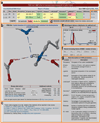Validation of metal-binding sites in macromolecular structures with the CheckMyMetal web server
- PMID: 24356774
- PMCID: PMC4410975
- DOI: 10.1038/nprot.2013.172
Validation of metal-binding sites in macromolecular structures with the CheckMyMetal web server
Abstract
Metals have vital roles in both the mechanism and architecture of biological macromolecules. Yet structures of metal-containing macromolecules in which metals are misidentified and/or suboptimally modeled are abundant in the Protein Data Bank (PDB). This shows the need for a diagnostic tool to identify and correct such modeling problems with metal-binding environments. The CheckMyMetal (CMM) web server (http://csgid.org/csgid/metal_sites/) is a sophisticated, user-friendly web-based method to evaluate metal-binding sites in macromolecular structures using parameters derived from 7,350 metal-binding sites observed in a benchmark data set of 2,304 high-resolution crystal structures. The protocol outlines how the CMM server can be used to detect geometric and other irregularities in the structures of metal-binding sites, as well as how it can alert researchers to potential errors in metal assignment. The protocol also gives practical guidelines for correcting problematic sites by modifying the metal-binding environment and/or redefining metal identity in the PDB file. Several examples where this has led to meaningful results are described in the ANTICIPATED RESULTS section. CMM was designed for a broad audience--biomedical researchers studying metal-containing proteins and nucleic acids--but it is equally well suited for structural biologists validating new structures during modeling or refinement. The CMM server takes the coordinates of a metal-containing macromolecule structure in the PDB format as input and responds within a few seconds for a typical protein structure with 2-5 metal sites and a few hundred amino acids.
Figures




References
-
- Harding MM, Nowicki MW, Walkinshaw MD. Metals in protein structures: a review of their principal features. Crystallogr Rev. 2010;16:247–302.
-
- Pozharski E, Weichenberger CX, Rupp B. Techniques, tools and best practices for ligand electron-density analysis and results from their application to deposited crystal structures. Acta Crystallogr. D. 2013;69:150–167. - PubMed
Publication types
MeSH terms
Substances
Grants and funding
LinkOut - more resources
Full Text Sources
Other Literature Sources

